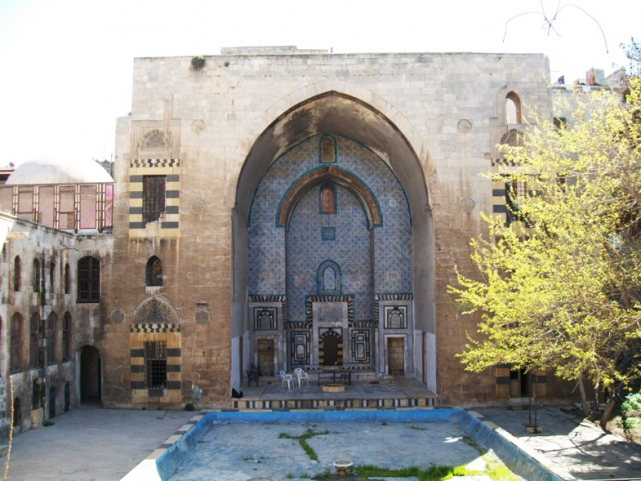When I lived in Syria, I hadn’t even heard about the Janbolad (Junblatt) Palace until 2011, my third year as an archaeology student. I was very surprised that a palace like this existed in my city. I did not expect its beauty, because just a few people even knew the palace’s name and location.
The first time I went to visit Dar Janbolad it was closed and there were no signs. I climbed up the northern external wall. The magnificent Iwān appeared and I immediately fell in love with it.
I knocked on the door of the adjacent house, which originally was part of the palace. It was renovated and a family lived there. A man opened the door and told me that although the Dar wasn’t always open to the public, its watchman, Abu Rami, came frequently to check on it. He gave me Abu Rami’s phone number. I called him and he promised to come the next day to open the house. The neighbour and his wife invited me in to see their well-cared for home.
The next day Abu Rami came. He was mellow. I introduced myself as an archaeology student, and he allowed me into the house. He had a few belongings there, a set of chairs and a Primus stove to make his coffee.
I passed through the small door into a narrow corridor and reached the courtyard. I had turned left to see the Iwān. The surprise and awe I felt at that first glance! Its height grips you with its grandeur. I felt like an ant next to it. Where did this little door lead me?!
I’ve loved blue since my early childhood, and the qashani tiles covering Janbolad’s Iwān enchanted me with their colour and motifs. I talked a bit with Abu Rami and asked him about his feelings when he comes to this beautiful house as if he were its owner. He told me that he liked to come water the plants and enjoyed the serenity of the place as he drank his coffee before heading back home. He told me there was talk of selling the palace, which, according to him, would fetch about 1 billion Syrian Lira, or 20 million dollars. “It would break my heart not to be able to visit it anymore.”
As Abu Rami guided me through every room and nook, I imagined being able to buy this palace, living in it and sitting by its fountain.
The last photo in this piece is of a qashani tile I had cleaned and photographed to show the beauty of the shade of blue that filled the palace.
Dar Janbolad, or Janbolad House/Palace, is located near Bāb an-Nasr, one of Old Aleppo’s historical gates. Built in the 16th century, the palace’s area was approximately 5000m2.
It was owned by the Al-Isbaʽ family before Janbolad Bey, an emir close to the Ottoman Sultan Suleiman the Magnificent, acquired it. The name Jānbolād means the spirit of steel. The house was later owned by Sheikh Hasan Afandi Al-Kawākbi, a Mufti of Aleppo.
During the French Occupation, the palace was used as a gathering place for the National Bloc, because the owner, Father Hasan Bey, was a member. Fifteen per cent of the palace was donated to the Awqāf and was used as al-Ghāfiqiya school. After that, the palace fell out of use.
The architectural elements of the palace evolved as it transitioned from the Mamluk period to the Ottoman period.
When I first entered the palace’s small door, it was a very simple entrance, similar to other Arabic courtyard houses in Aleppo. The corridor leads to a big courtyard and a huge, 30-metre-high, blue Iwān. The Iwān is considered the biggest not only in Aleppo, but in Syria as well. Only one palace Iwān located in Isfahan is said to match its size. The walls are covered with fine qashani ceramic-tiled mosaics. The room on the western side of the Iwān was the room of the Syrian progressive thinker ʽAbd ar-Rahmān Al-Kawākibi.

Before the war (2011): The Small Winter Iwān on the northern side and the fountain. Photo: Tiffany Ftaimi.
In the centre of the courtyard is Aleppo’s largest water fountain, measuring 10.5m*16.30m*65cm. Opposite the Iwān on the northern side lies a small Winter Iwān. Its outer façade was built with black and yellow stones, in an alternating style called “Ablaq.” The Iwān has been partly damaged during the current war in Syria.
Some parts of the palace were separated from it and used for different purposes, such as a khan – or caravanserai – a soap factory and houses. Some of the elements date back to the end of the Mamluk period and not to the Ottoman period.
The urban fabric of the neighbourhood changed significantly and was re-organized during the important social and economic changes in the Ottoman era.
The condition of the palace was unfortunate in 2011, but it could be restored and used for different purposes. Its most important purpose would be as an archaeological and touristic monument, because it is a very unique palace in the Arab world and it is our duty to save our heritage.
When I return to Syria one day, visiting Dar Janbolad will be among my first stops, because of how much I cherish it and the beautiful memories it evokes.
Tiffany Ftaimi is a Syrian-Hungarian archaeologist. She graduated with highest distinction from the University of Aleppo’s Archaeology Department. She has worked with prominent experts on Syrian and European sites and is currently completing her Master’s degree in Near Eastern Archaeology at Heidelberg University in Germany.
This article draws, in part, on the following books: Jean Claude David, translated by Mahmoud Heritani (2010) Awābed Sweqet ʽAli; Lamia Jasser and others (2010) Taqaṣṣi Ḫuṭā ad-Dawle Al-ʽUṯmāniya fi Ḥalab; Abd Allah Hajjar (2010) Maʽālem Ḥalab Al-aṯariya.
Both English and Arabic versions of the article are by the author.
 The Aleppo Project
The Aleppo Project






